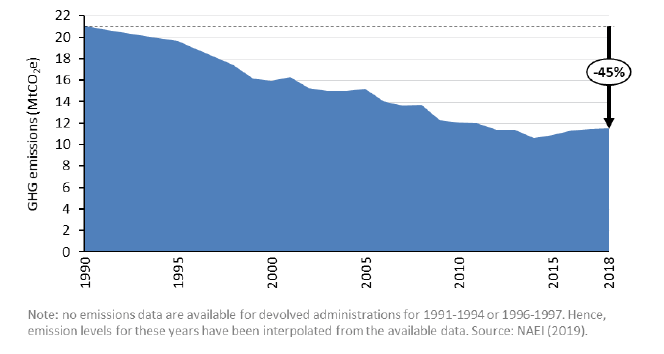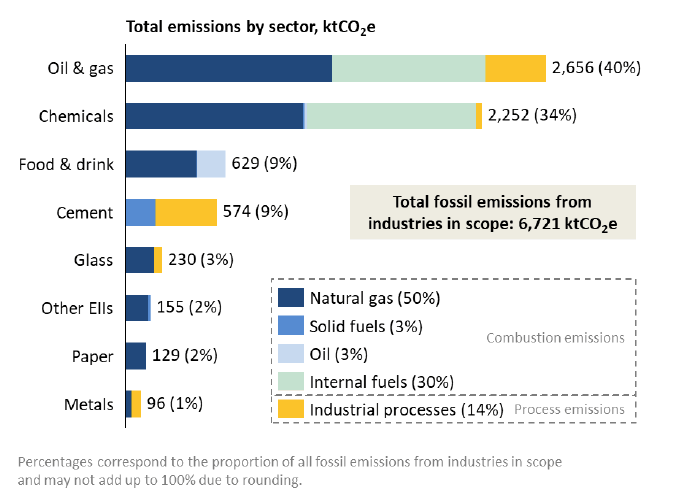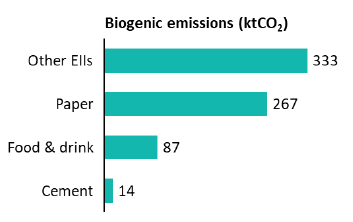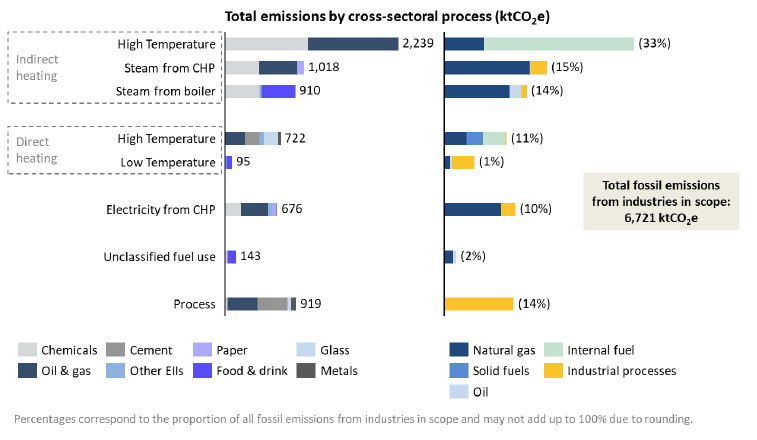Deep decarbonisation pathways for Scottish industries: research report
The following report is a research piece outlining the potential pathways for decarbonisation of Scottish Industries. Two main pathways are considered, hydrogen and electrification, with both resulting in similar costs and levels of carbon reduction.
3 Overview of emissions in scope
3.1 Historical emissions and reductions since 1990
Emissions from all Scottish industries amounted to 21.0 MtCO2e in 1990, the baseline year for both the Climate Change (Scotland) Act 2009 and the Paris Agreement. Asshown in Figure 3, emissions had fallen 45% by 2018, reaching 11.5 MtCO2e. Unfortunately, it is not known what percentage of the 1990 emissions refers to industries in scope, hence it is not possible to determine the baseline level of emissions from these.

Analysis from the Committee for Climate Change (CCC) however shows that the following have contributed the most to emissions reductions since 1990:[34]
- The closure of the Ravenscraig steelworks in 1992 reduced emissions by over 3.5 MtCO2e.
- Emissions from paper, print and publications reduced by over 1.5 MtCO2e.
- Fugitive emissions from fossil fuels reduced by about 2.5 MtCO2e.
Combined, the above contributed nearly 80% of the emissions reduction from all Scottish industries, which indicates that emissions reductions from the other industries in scope must have been significantly lower than the 45% average and that emissions from certain sectors have in fact increased significantly in this time. It should also be noted that only part of the emissions reduction since 1990 resulted from decarbonisation of industrial processes. Indeed, the CCC highlights that "structural changes to the manufacturing sector (i.e. faster growth for lower-carbon parts of the manufacturing sector)" significantly contributed to reducing overall emissions.[35]
Additionally, while UK territorial emissions reduced by 41% between 1990 and 2016, consumption-based emissions only reduced by 15% over the same period.[36] Although the current emissions targets only relate to territorial emissions, the smaller reduction in consumption-based emissions may represent an issue at a global level since it implies that a lower overall level of abatement has been attained since the baseline year. Furthermore, the divergence between territorial and consumption-based emissions also hints at the progressive relocation of energy-intensive industries away from the UK – an issue known as 'carbon leakage' which is discussed further in the concluding chapter.
3.2 Emissions by sector and by source
Industrial emission sources can be categorised at a high level depending on whether they yield 'combustion' or 'process' emissions:
- Combustion emissions arise from the combustion of fuels to supply the energy required by the industrial processes and can be broken down according to the type of fuel used.
- Process emissions instead refer to the greenhouse gases produced within the chemical reactions involved in some industrial process (discussed below) and subsequently released to the atmosphere.

As can be seen in Figure 4, which shows a breakdown of the sectoral emissions following the categorisation proposed above, 86% of all emissions from industries in scope can be classified as combustion emissions and 14% as process emissions. It should be noted that only fossil emissions are analysed below, though some of the industries in scope also emit biogenic CO2 from the combustion of biomass or biogas. In accordance with carbon accounting standards, biogenic emissions are treated as carbon neutral, hence the pathways assessed do not consider strategies to reduce them.[37] Since bioenergy sources constitute a sizeable share of the energy used by certain industries, biogenic emissions are discussed further in Box 1.
Emissions from the combustion of purchased fossil fuel
Purchased fossil fuel combustion is the single largest category of emissions sources, responsible for 56% of all emissions (from the industries in scope, henceforth emitted).[38] These relate chiefly to natural gas combustion, to which 89% of the corresponding emissions can be linked. Solid fuels[39] and oil are also used, for instance in processes where their use more efficiently generates the intense flames useful to achieve the high temperatures necessary for certain chemical reactions[40] or at sites not connected to the gas grid (e.g. in the food and drink sector).
Emissions from the combustion of internal fuels
Emissions from the combustion of 'internal fuels' account for 30% of all emissions. Internal fuels are industry by-products that cannot be sold or serve any other purpose and are therefore generally burned on-site. Specifically, the internal fuels relevant to Scottish industries are:
- fuel 'off-gases' co-produced within the refining and olefins steam cracking process,[41] and
- petroleum coke ('pet-coke') produced and consumed within the refinery's fluid catalytic cracker (FCC).
Since internal fuels are co-produced in fixed proportions to the main output product[42] and must always be burnt, emissions from their combustion cannot be reduced without changing the process and can therefore only be captured.[43] It could of course be possible for internal fuels to be sold to third parties instead of being burnt on site, but, since these third parties would most likely also have to burn them, no net emissions abatement is expected to occur via this route, hence this option is not considered further.
Process emissions
As mentioned above, industrial processes contribute 14% of all emissions. The main processes that give rise to direct emissions in Scotland include:
- The calcination reaction occurring within the cement kiln (42% of all process emissions).
- Steam methane reforming (SMR)[44] at the Grangemouth refinery (20%).
- Carbon anode degradation in the aluminium electrolysis process (7%).
- Raw material degradation during glass melting (5%).
- CO2 separation and purging of the flare heads within the gas terminal (4% and 2%, respectively).
- The remaining (20%) is related to flaring at the Grangemouth refinery and gas terminal, and at petrochemical sites.
As in the case of emissions from internal fuel combustion, process emissions are also unaffected by energy efficiency improvements and fuel switching. Instead, their abatement must rely on alternative methods like CCUS (not generally applicable to flaring emissions, as discussed below), product substitution, process change, or potentially on the development of breakthrough technologies. Among these options, this study performs a quantitative assessment of process emissions abatement via CCUS; other options, which are speculative at this stage and of limited applicability, are instead considered in the context of abating residual emissions (Section 6.1.4).
It is worth noting that flaring is not technically considered a source of process emissions, since the CO2 is emitted following the combustion of hydrocarbon gases, which would suggest categorising flaring as a source of combustion emissions. Where flaring however diverges from all other combustion emission sources is in the fact that gases are not flared to supply energy to industrial processes. Rather, flaring is carried out for operational reasons, for instance to prevent the potentially explosive build-up of feedstock gases or to avoid the release of methane-rich gases with a global warming potential far higher than that of CO2. Furthermore, flaring-related emissions are unlikely to be suitable for CCUS due to safety and economic reasons, thoughfurther work may find cases were this is applicable. [45]
Box 1 – Biogenic emissions
The combustion of biomass and biogas (collectively 'bioenergy') for energy generation leads to emissions of CO2 (an estimated 0.7 MtCO2 in the case of the industries in scope). In accordance with typical carbon accounting standards, biogenic emissions areconsidered carbon neutral. The reason for this assumption is that the carbon stored within all bioenergy sources was previously extracted from the atmosphere by the source trees or other vegetation. It is however acknowledged that the existence of emissions from the bioenergy supply chain (e.g. transportation) as well as emissions related to 'land use and land use change' (LULUC) may imply that not all biogenic emissions are carbon neutral.
Since biogenic emissions are considered carbon neutral, this study does not consider ways to reduce them. Nevertheless, their inclusion in the analysis is useful to obtain a more accurate assessment of the energy and fuel requirements across the different industrial process in Scotland. Specifically, biogenic emissions originate from the following processes:
- Biomass combustion at some of the paper manufacturing and wood processing sites (listed under 'other EIIs'), from which 86% of all biogenic emissions arise.
- Appliances that combust biogas and biomass residues from some of the Scotch Whisky distilleries. The biogas is itself often produced on-site from the anaerobic digestion of organic distillery by-products.[46] This is a fuel-switching option not quantitatively assessed within this study but reviewed in Box 2.
- A proportion of biomass contained in the waste-derived fuels burnt in the cement industry.
For clarity, all references to industrial emissions in this report are to be interpreted as referring to fossil CO2 arising from fuel combustion or from other processes, unless otherwise specified.

3.3 Emissions by cross-sectoral process
Combustion emissions can be broken down according to whether fuels are burnt to generate heat or electricity (the latter of which mostly happens within on-site combined heat and power, or CHP, plants). Furthermore, heating processes can be categorised according to four cross-sectoral processes differentiated by whether the process materials are directly exposed to combustion gases or not (direct vs indirect heating), and depending on whether steam, high- or low-temperature heat are needed, as summarised in Table 2. (A comprehensive list of all sector-specific processes and their cross-sectoral counterparts is provided in Appendix 8.4.)
| Cross-sectoral heating process | Representative technology | Main sectors or subsectors relying on these processes | |
|---|---|---|---|
| Indirect heating | High temperature | Furnaces (up to 850°C) | Refining, petrochemicals |
| Steam-driven | Boilers and CHP plants (up to 240°C) | Food & drink, paper, chemicals, other EIIs | |
| Direct heating | High temperature | Kilns, smelters, and other furnaces (up to 2000°C) | Glass, cement, other non-metallic minerals |
| Low temperature | Dryers, ovens | Food & drink, veneer sheets and wood-based panels | |
The emissions breakdown shown in Figure 6 (see Appendix 8.5 for the breakdown in table format) was obtained by dividing the 6.7 MtCO2e emitted by industries in scope according to the cross-sectoral process and fuel from which they are estimated to arise. Here, emissions are also broken down by sector (on the left-hand side) or fuel type/process (on the right-hand side).

This breakdown highlights that indirect and direct heating processes collectively account for nearly three quarters (74%) of all emissions, that electricity generation in on-site CHP plants contributes 10% of all emissions, and that about 2% of all emissions arise from processes that could not be classified due to data limitations. As previously noted, industrial processes are responsible for the remaining 14% of emissions.
Heating related emissions
These results highlight the importance of decarbonising industrial heat to achieve deep emissions reductions, which warrants further investigation into the corresponding emission sources:
- Indirect high-temperature heating processes employed in the oil and gas and petrochemical industries are the single largest category of industrial emission in Scotland, collectively contributing 33% of all emissions.[47] This category brings together processes where temperatures of up to 850°C are attained by passing process gases through furnace coils. Nearly 80% of the energy demand for these processes is met via internal fuel combustion, which underlines the importance of CCUS or process changes to decarbonise these processes.
- Indirect heating processes making use of steam account for 29% of all emissions. Steam of up to 240°C is the most often used energy carrier[48] for indirect heating processes and can be generated via boilers or CHP plants, assessed separately as they may be decarbonised in different ways. Hot water can also be used at lower temperatures, but that is more often used by non-industrial users.
- Furnaces, kilns, and other direct, high-temperature processes are collectively responsible for 11% of all emissions. These processes expose process materials to naked flame and combustion gases reaching very high temperatures of up to 2000°C, required to trigger the core reactions for clinker production, glass smelting, and metal processing.
- Direct low-temperature heating processes like dryers and ovens account for just over 1% of all fossil emissions. These are mostly employed in the wood processing and food and drink sectors, and air is the usual energy carrier within these processes.
Power related emissions
As mentioned, 10% of the emissions relate to electricity generation in on-site CHP plants, which is additional to those emissions related to the generation of grid electricity (not assessed here as they are classified as scope 2). While this indicates that electricity generation is a relatively small contributor to scope 1 industrial emissions, it is noted that electricity can in some cases constitute a high share of the energy used by industrial sites; in the paper and pulp industry, for instance, approximately 60% of all energy used is electricity.[49] Electricity also plays an important role in larger Scottish industries like olefins production, refining, and cement manufacturing, but it represents a far smaller share of the overall energy demand.[50]
The quantitative analysis presented above exclusively focuses on carbon dioxide emissions from the sites within the scope defined in Section 2.2. As previously noted, this is because emissions from smaller sites as well as emissions of other greenhouse gases could not be attributed to specific sites or sectors due to data limitations. These two emissions sources are briefly reviewed in the appendix.
Contact
Email: Michael.Cairns2@gov.scot
There is a problem
Thanks for your feedback